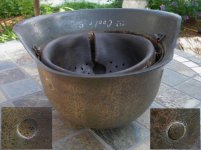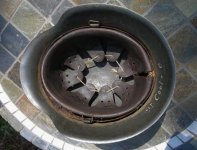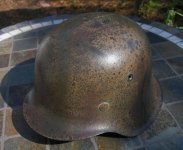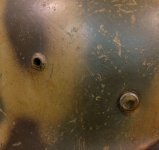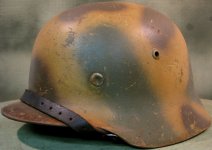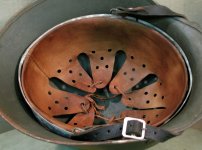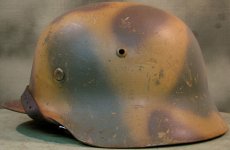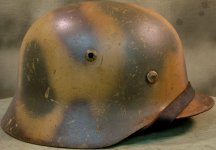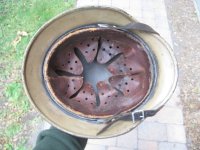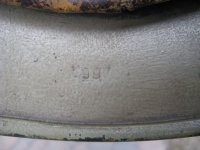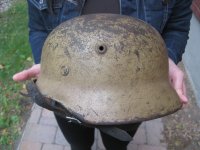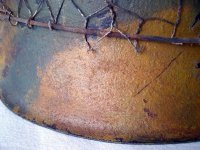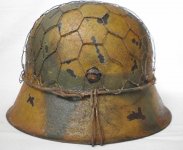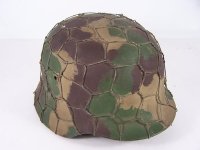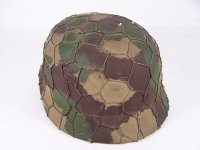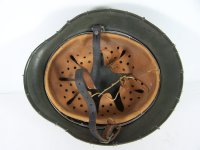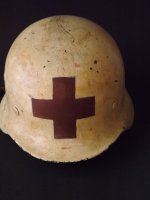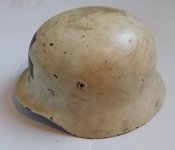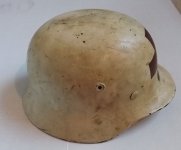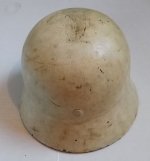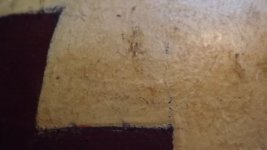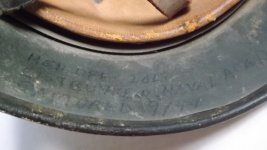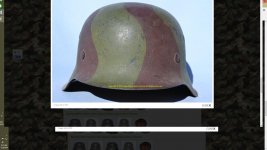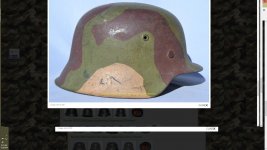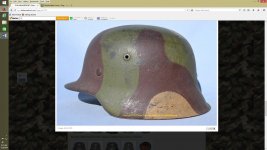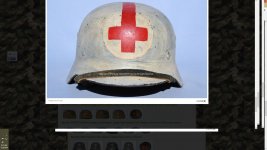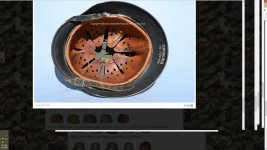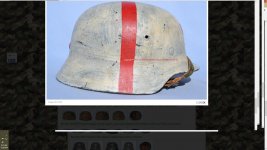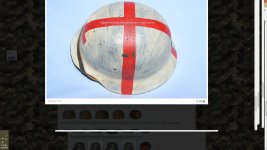You are using an out of date browser. It may not display this or other websites correctly.
You should upgrade or use an alternative browser.
You should upgrade or use an alternative browser.
Questionable Camos
- Thread starter M45
- Start date
M45
Well-known member
Thanks for the 'virtual beer' Ham; tastes great!
Ebay item# 301315083761
THERE ARE NO BANNED SYMBOLS IN THIS AUCTION!
This is a great looking combat experienced M1942 Camouflaged German Army helmet. This WWII German Army helmet retains much of its camouflaged paint. The dome has no indentations and no cracks to the helmet shell. No dome stamp found. The exterior has a really great "been there, done that" look. The Split pin rivets are tight, intact, and are certain to be original to the helmet. Round metal split rivet backing washers are there. This German helmet has the correct zinc galvanized steel banded M1931 liner, the steel liner band is well rusted though, heavily rusted, even so suspension system still does remain intact. The liner band itself is too rusty to see any markings. Helmet is maker size stamped ckl 66 on rear skirt. The leather is in good overall condition but is missing its vertical leather stitching at the back of the liner. Leather is probably size 58 which is correct for size 66 shell, leather wears like size 58. Some of the small round leather drawstring backing washers are missing. The helmets drawstring is present and is in good condition, drawstring was just hanging there on a couple of the leather pass thru holes years back, reinstalled it. The army SD ghost, remnants, remains left side. This M42 German WWII helmet is a “ckl” indicating manufacture by the Eisenhuttenwerke firm in Thale, Germany. The steel heat lot number appears to read 3861. This original helmet with Normandy camouflaged paint was collected here long ago and displays particularly well. Partial German Soldier ID painted on rear skirt. Although the steel liner band itself is salty, split pin rivets too are salty, rest of it is just darn cool.
Looks like chemical aging to the paint. Also repetitive tooling marks. Lot# 3861 is too high for factory heer decals on ckl helmets (3584 maximum as of this writing), so there should be no ghosted image. Repro liner.
Ebay item# 301315083761
THERE ARE NO BANNED SYMBOLS IN THIS AUCTION!
This is a great looking combat experienced M1942 Camouflaged German Army helmet. This WWII German Army helmet retains much of its camouflaged paint. The dome has no indentations and no cracks to the helmet shell. No dome stamp found. The exterior has a really great "been there, done that" look. The Split pin rivets are tight, intact, and are certain to be original to the helmet. Round metal split rivet backing washers are there. This German helmet has the correct zinc galvanized steel banded M1931 liner, the steel liner band is well rusted though, heavily rusted, even so suspension system still does remain intact. The liner band itself is too rusty to see any markings. Helmet is maker size stamped ckl 66 on rear skirt. The leather is in good overall condition but is missing its vertical leather stitching at the back of the liner. Leather is probably size 58 which is correct for size 66 shell, leather wears like size 58. Some of the small round leather drawstring backing washers are missing. The helmets drawstring is present and is in good condition, drawstring was just hanging there on a couple of the leather pass thru holes years back, reinstalled it. The army SD ghost, remnants, remains left side. This M42 German WWII helmet is a “ckl” indicating manufacture by the Eisenhuttenwerke firm in Thale, Germany. The steel heat lot number appears to read 3861. This original helmet with Normandy camouflaged paint was collected here long ago and displays particularly well. Partial German Soldier ID painted on rear skirt. Although the steel liner band itself is salty, split pin rivets too are salty, rest of it is just darn cool.
Looks like chemical aging to the paint. Also repetitive tooling marks. Lot# 3861 is too high for factory heer decals on ckl helmets (3584 maximum as of this writing), so there should be no ghosted image. Repro liner.
Attachments
Last edited:
M45
Well-known member
M-35 DAK Camo
WW2 Original German Army M-35 DAK Camo Helmet
Ebay Item# 191336515241
This is a great helmet. M-35 SD Heer (SD lightly cover by paint) helmet with camo paint even in the skirt of the helmet. Please see photos for more details. 1937 linner (see photo, it can be seen). Leather linner in very worn condition but still soft but fragile. You can handle the leather with little care.
The helmet has a pinkish brown color paint base or original layer of paint (associated with Afrika Korps helmets). At a later time other layer of light sand brown was applied. Then some light green paint color was applied too.
The lot number can't be seen, is under the paint.
Photos can't describe it properly. Excellent piece.
In untouched condition since the war.
I see a well-aged finish, but not well worn. Many areas pristine. No appreciable field wear on this one. The crown has those similar odd holes in the paint with pristine paint in between.
WW2 Original German Army M-35 DAK Camo Helmet
Ebay Item# 191336515241
This is a great helmet. M-35 SD Heer (SD lightly cover by paint) helmet with camo paint even in the skirt of the helmet. Please see photos for more details. 1937 linner (see photo, it can be seen). Leather linner in very worn condition but still soft but fragile. You can handle the leather with little care.
The helmet has a pinkish brown color paint base or original layer of paint (associated with Afrika Korps helmets). At a later time other layer of light sand brown was applied. Then some light green paint color was applied too.
The lot number can't be seen, is under the paint.
Photos can't describe it properly. Excellent piece.
In untouched condition since the war.
I see a well-aged finish, but not well worn. Many areas pristine. No appreciable field wear on this one. The crown has those similar odd holes in the paint with pristine paint in between.
Attachments
-
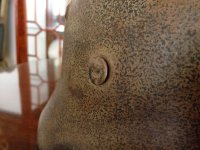 DAK DETAIL.JPG253.2 KB · Views: 23
DAK DETAIL.JPG253.2 KB · Views: 23 -
 DAK FRONT.JPG233.8 KB · Views: 20
DAK FRONT.JPG233.8 KB · Views: 20 -
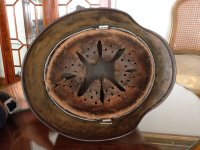 DAK LINER.JPG252.3 KB · Views: 12
DAK LINER.JPG252.3 KB · Views: 12 -
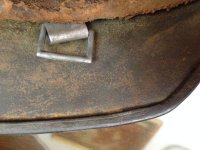 DAK MARK.JPG269.3 KB · Views: 12
DAK MARK.JPG269.3 KB · Views: 12 -
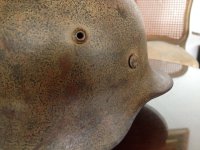 DAK R DETAIL.JPG254.8 KB · Views: 10
DAK R DETAIL.JPG254.8 KB · Views: 10 -
 DAK REAR.JPG219.4 KB · Views: 12
DAK REAR.JPG219.4 KB · Views: 12 -
 DAK RS.JPG224.5 KB · Views: 14
DAK RS.JPG224.5 KB · Views: 14 -
 DAK TOP.jpg256.4 KB · Views: 18
DAK TOP.jpg256.4 KB · Views: 18 -
 DAK TOP DETAIL.JPG214.1 KB · Views: 11
DAK TOP DETAIL.JPG214.1 KB · Views: 11
M45
Well-known member
postwar shell with camo
A postwar shell with camo Well-distributed minor wear, often seen on original shell camos.
A postwar shell with camo Well-distributed minor wear, often seen on original shell camos.
Attachments
M45
Well-known member
Luftwaffe dak
LUFTWAFFE - DAK
Ebay item# 121442249174
DESCRIPTION
German helmet for sale exactly as seen in photos. I have been told this is from World War II however I could be mistaken about that. Has some letter markings on the inside. Sold as is no returns please since I am selling for a friend of the family.
Shipping will be $15 to anywhere in North America and $50 for anywhere else with tracking numbers of course.
Thanks....
LUFTWAFFE - DAK
Ebay item# 121442249174
DESCRIPTION
German helmet for sale exactly as seen in photos. I have been told this is from World War II however I could be mistaken about that. Has some letter markings on the inside. Sold as is no returns please since I am selling for a friend of the family.
Shipping will be $15 to anywhere in North America and $50 for anywhere else with tracking numbers of course.
Thanks....
Attachments
M45
Well-known member
Normandy Camo" paratrooper
NEW! Item 959 M38 "Normandy Camo" paratrooper helmet
http://www.germanhelmetsinc.com/helmetssale.htm
Here is a top-shelf example of an M38 paratrooper helmet with a two-color sawdust camouflage pattern which is often referred to as the "6th Fallschirm regiment pattern" because of like examples having been brought home by US 101st airborne veterans from Carentan, Normandy. The spray camo covers the area where the Luftwaffe decal would be and no trace of the decal is seen through the thick paint. The helmet is an ET71 and is dated by the lot number to a probable production period of Mid 1941. It would have had a decal applied at the factory. The liner and straps are completely intact. Each of the 4 spanner bolts has traces of the camouflage paint on them. Each of the bolts has a single threaded nut connecting on the inside. The foam rubber padding is all present and intact. Para helmets of this caliber are really very rarely offered.ON HOLD
A highly desirable camo para that has unit association, no less. I never got the price on this one, but I suspect it was over the 10K range. The liner has clearly been out of this one due to the multiple dents in the liner band. Also, it looks like the liner was out when it was camoed due to the camo paint underneath the bolts. Why would a trooper remove the liner of a helmet before a camo paint job? That would mean that the camoed bolts were painted separately and then reinstalled on the helmet after drying. That indicates whoever did this job had plenty of TIME on their hands. The pristine condition of the woodchips can be seen in the detail photos of the rear and side bolts. I detect a faint cloth pattern in the crown detail photo; a camo cover on top of camo paint? That would certainly explain the pristine condition of the paint. Very heavy wear (scrapes) to certain areas, but other areas seem to have been completely untouched by wear (abnormal wear patterns).
No doubt a 'top-shelf' example to some collectors, but when one takes a second, more detailed look, the helmet does not seem to be consistent with known original camos.
Also, it is common on original camos to see the factory paint peeking through the damaged areas of the camo, sometimes with the same wear marks affecting both finishes. I can see absolutely no factory paint on the outside of this helmet. Considering that camos were front line helmets, often with some of the heaviest wear seen on German Helmets; camos with pristene areas, little wear, and no factory paint visible in the damaged areas should raise suspicion.
One reason why we see this is that many helmets were 'abused' over the years by vets and others by repainting and or stripping off the original finishes. Although the liners and underside finishes may be untouched, the exteriors of these helmets have been damaged beyond repair. Such helmets are prime candidates for camo paint, so be weary when no factory paint can be seen.
NEW! Item 959 M38 "Normandy Camo" paratrooper helmet
http://www.germanhelmetsinc.com/helmetssale.htm
Here is a top-shelf example of an M38 paratrooper helmet with a two-color sawdust camouflage pattern which is often referred to as the "6th Fallschirm regiment pattern" because of like examples having been brought home by US 101st airborne veterans from Carentan, Normandy. The spray camo covers the area where the Luftwaffe decal would be and no trace of the decal is seen through the thick paint. The helmet is an ET71 and is dated by the lot number to a probable production period of Mid 1941. It would have had a decal applied at the factory. The liner and straps are completely intact. Each of the 4 spanner bolts has traces of the camouflage paint on them. Each of the bolts has a single threaded nut connecting on the inside. The foam rubber padding is all present and intact. Para helmets of this caliber are really very rarely offered.ON HOLD
A highly desirable camo para that has unit association, no less. I never got the price on this one, but I suspect it was over the 10K range. The liner has clearly been out of this one due to the multiple dents in the liner band. Also, it looks like the liner was out when it was camoed due to the camo paint underneath the bolts. Why would a trooper remove the liner of a helmet before a camo paint job? That would mean that the camoed bolts were painted separately and then reinstalled on the helmet after drying. That indicates whoever did this job had plenty of TIME on their hands. The pristine condition of the woodchips can be seen in the detail photos of the rear and side bolts. I detect a faint cloth pattern in the crown detail photo; a camo cover on top of camo paint? That would certainly explain the pristine condition of the paint. Very heavy wear (scrapes) to certain areas, but other areas seem to have been completely untouched by wear (abnormal wear patterns).
No doubt a 'top-shelf' example to some collectors, but when one takes a second, more detailed look, the helmet does not seem to be consistent with known original camos.
Also, it is common on original camos to see the factory paint peeking through the damaged areas of the camo, sometimes with the same wear marks affecting both finishes. I can see absolutely no factory paint on the outside of this helmet. Considering that camos were front line helmets, often with some of the heaviest wear seen on German Helmets; camos with pristene areas, little wear, and no factory paint visible in the damaged areas should raise suspicion.
One reason why we see this is that many helmets were 'abused' over the years by vets and others by repainting and or stripping off the original finishes. Although the liners and underside finishes may be untouched, the exteriors of these helmets have been damaged beyond repair. Such helmets are prime candidates for camo paint, so be weary when no factory paint can be seen.
Attachments
-
 M38 DETAIL.jpg292.6 KB · Views: 20
M38 DETAIL.jpg292.6 KB · Views: 20 -
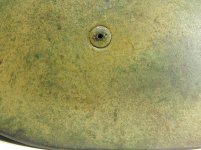 M38 DETAIL DECAL.jpg296.7 KB · Views: 19
M38 DETAIL DECAL.jpg296.7 KB · Views: 19 -
 M38 DETAIL REAR.jpg299.9 KB · Views: 17
M38 DETAIL REAR.jpg299.9 KB · Views: 17 -
 M38 DETAIL RIVET.jpg307.8 KB · Views: 19
M38 DETAIL RIVET.jpg307.8 KB · Views: 19 -
 M38 LF.jpg186 KB · Views: 19
M38 LF.jpg186 KB · Views: 19 -
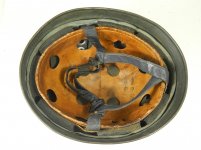 M38 LINER.jpg190.5 KB · Views: 22
M38 LINER.jpg190.5 KB · Views: 22 -
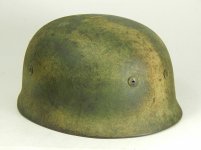 M38 LR.jpg162 KB · Views: 14
M38 LR.jpg162 KB · Views: 14 -
 M38 LS.jpg189.5 KB · Views: 13
M38 LS.jpg189.5 KB · Views: 13 -
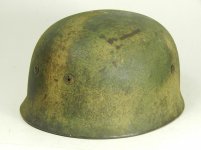 M38 RR.jpg182 KB · Views: 12
M38 RR.jpg182 KB · Views: 12 -
 M38 RS.jpg176.1 KB · Views: 13
M38 RS.jpg176.1 KB · Views: 13
Last edited:
M45
Well-known member
A 100% fake
Ebay helmet from Germany. $890. I see nothing original on this helmet, not even the shell. Note the fake stamps.
Original German WW 2 - M 42 Helmet - camoflage
shell marker ckl64 & 4346 , liner marker 6 - 43 R.B.Nr. 10 / 1805 / 0327 , chinstrap marker Wilhelm Ellers, Bielefeld 1942
I ship this item from Germany, the shipping costs are $ 45 with a registered mail , shipping time is approx. 14 - 20 business - days.
I accept paypal payments &cash payments, to combine a shipment is no problem,
Ebay helmet from Germany. $890. I see nothing original on this helmet, not even the shell. Note the fake stamps.
Original German WW 2 - M 42 Helmet - camoflage
shell marker ckl64 & 4346 , liner marker 6 - 43 R.B.Nr. 10 / 1805 / 0327 , chinstrap marker Wilhelm Ellers, Bielefeld 1942
I ship this item from Germany, the shipping costs are $ 45 with a registered mail , shipping time is approx. 14 - 20 business - days.
I accept paypal payments &cash payments, to combine a shipment is no problem,
Attachments
M45
Well-known member
Wehrmacht M35 tropical helmet
Wehrmacht M35 tropical helmet
Starting price: € 250,00
Wehrmacht M35 tropical helmet
Wehrmacht M35 helmet with tropical paint. The inside of the shell looks absolutely period time painted/strayed. The outside looks touched and ground and shows rust. The soft leather liner is 56 size stamped. The shell is EF64 stamped and depot marked. Certainly a very unusual helmet.
http://www.ratisbons.com/1st-Contemporary-History-Auction/Wehrmacht-M35-tropical-helmet.html
A number of problems with this one, not the least being that the tan paint was applied on top of a bare shell; no factory paint is visible. The lack of believable wear marks and generous red rust are basically redundant at this point. Original tropical camos will have their tan paint applied on top of the factory finish. There was no need to remove any of the factory paint before the application of camo. Also, liners were generally not removed, so any paint to the interior would NOT include the interior bowl. (field applied camo)
Liners were occasionally removed at depots to paint the interiors, interior dome included, but usually this was not done if there was no liner replacement. (depot applied refurbishment)
Wehrmacht M35 tropical helmet
Starting price: € 250,00
Wehrmacht M35 tropical helmet
Wehrmacht M35 helmet with tropical paint. The inside of the shell looks absolutely period time painted/strayed. The outside looks touched and ground and shows rust. The soft leather liner is 56 size stamped. The shell is EF64 stamped and depot marked. Certainly a very unusual helmet.
http://www.ratisbons.com/1st-Contemporary-History-Auction/Wehrmacht-M35-tropical-helmet.html
A number of problems with this one, not the least being that the tan paint was applied on top of a bare shell; no factory paint is visible. The lack of believable wear marks and generous red rust are basically redundant at this point. Original tropical camos will have their tan paint applied on top of the factory finish. There was no need to remove any of the factory paint before the application of camo. Also, liners were generally not removed, so any paint to the interior would NOT include the interior bowl. (field applied camo)
Liners were occasionally removed at depots to paint the interiors, interior dome included, but usually this was not done if there was no liner replacement. (depot applied refurbishment)
Attachments
-
 94aheli1.jpg102.2 KB · Views: 12
94aheli1.jpg102.2 KB · Views: 12 -
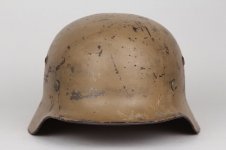 94aheli2.jpg95.7 KB · Views: 8
94aheli2.jpg95.7 KB · Views: 8 -
 94aheli3.jpg110.7 KB · Views: 12
94aheli3.jpg110.7 KB · Views: 12 -
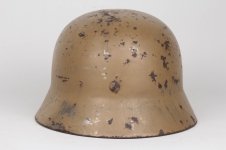 94aheli4.jpg97.2 KB · Views: 7
94aheli4.jpg97.2 KB · Views: 7 -
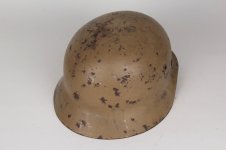 94aheli6.jpg96.4 KB · Views: 5
94aheli6.jpg96.4 KB · Views: 5 -
 94aheli15.jpg118.5 KB · Views: 8
94aheli15.jpg118.5 KB · Views: 8 -
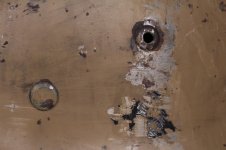 94aheli8.jpg160.6 KB · Views: 5
94aheli8.jpg160.6 KB · Views: 5 -
 94aheli11.jpg138.9 KB · Views: 5
94aheli11.jpg138.9 KB · Views: 5 -
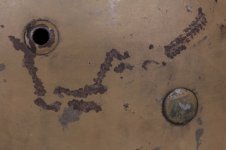 94aheli7.jpg153.1 KB · Views: 4
94aheli7.jpg153.1 KB · Views: 4 -
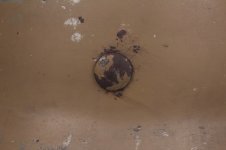 94aheli12.jpg111.7 KB · Views: 3
94aheli12.jpg111.7 KB · Views: 3
Last edited:
M45
Well-known member
Restored Luftwaffe M40 Afrikakorps helmet
http://www.ratisbons.com/1st-Contem...estored-Luftwaffe-M40-Afrikakorps-helmet.html
Restored Luftwaffe M40 Afrikakorps helmet
Original SF66 Wehrmacht M40 shell with an original size 58 liner. Replica chin strap. Modern paint and decals. A nicely restored helmet.
Starting price: € 150,00
This Luft camo is being sold as a copy. Note the contrived, repetitive wear marks to the crown.
http://www.ratisbons.com/1st-Contem...estored-Luftwaffe-M40-Afrikakorps-helmet.html
Restored Luftwaffe M40 Afrikakorps helmet
Original SF66 Wehrmacht M40 shell with an original size 58 liner. Replica chin strap. Modern paint and decals. A nicely restored helmet.
Starting price: € 150,00
This Luft camo is being sold as a copy. Note the contrived, repetitive wear marks to the crown.
Attachments
-
 LUFT CAMO FRONT.jpg124.2 KB · Views: 7
LUFT CAMO FRONT.jpg124.2 KB · Views: 7 -
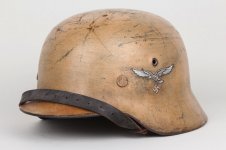 LUFT CAMO LF.jpg140.4 KB · Views: 10
LUFT CAMO LF.jpg140.4 KB · Views: 10 -
 LUFT CAMO LS.jpg148.5 KB · Views: 17
LUFT CAMO LS.jpg148.5 KB · Views: 17 -
 LUFT CAMO REAR.jpg127.4 KB · Views: 8
LUFT CAMO REAR.jpg127.4 KB · Views: 8 -
 LUFT CAMO RS.jpg149.1 KB · Views: 7
LUFT CAMO RS.jpg149.1 KB · Views: 7 -
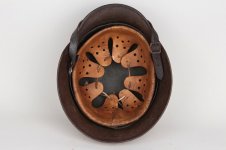 LUFT CAMO LINER.jpg116.4 KB · Views: 6
LUFT CAMO LINER.jpg116.4 KB · Views: 6 -
 LUFT CAMO TOP DETAIL 2.jpg217.4 KB · Views: 9
LUFT CAMO TOP DETAIL 2.jpg217.4 KB · Views: 9 -
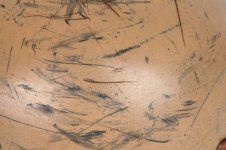 LUFT CAMO TOP DETAIL 3.jpg194.1 KB · Views: 8
LUFT CAMO TOP DETAIL 3.jpg194.1 KB · Views: 8 -
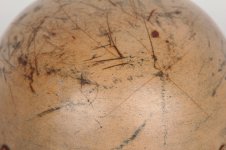 LUFT CAMO TOP DETAIL.jpg158.7 KB · Views: 7
LUFT CAMO TOP DETAIL.jpg158.7 KB · Views: 7
M45
Well-known member
http://www.italianwarfront.com/?page_id=9
DOT PATTERN CAMO - FALL COLORS
German dot pattern camo with vet family signed letter of provenance.
On hold until Nov. 8
And just in time for Thanksgiving!
At first glance, a stunning piece! I can only guess what it will sell for; 7K, 15K ?
I see no appreciable wear to the crown of this helmet, as if had been camoed but never actually worn in combat (in other words, a red flag). The paint is in fabulous condition.
When I compare this camo to REX-39s work, it is no longer surprising to me that recently camoed helmets can be aged so professionally to actually look like they are 70 years old.
If this camo is postwar, then its clear to me that the fakers have absolutely no shame; to take a very nice SD Heer helmet and apply camo to hump up its value.
DOT PATTERN CAMO - FALL COLORS
German dot pattern camo with vet family signed letter of provenance.
On hold until Nov. 8
And just in time for Thanksgiving!
At first glance, a stunning piece! I can only guess what it will sell for; 7K, 15K ?
I see no appreciable wear to the crown of this helmet, as if had been camoed but never actually worn in combat (in other words, a red flag). The paint is in fabulous condition.
When I compare this camo to REX-39s work, it is no longer surprising to me that recently camoed helmets can be aged so professionally to actually look like they are 70 years old.
If this camo is postwar, then its clear to me that the fakers have absolutely no shame; to take a very nice SD Heer helmet and apply camo to hump up its value.
Attachments
-
 AUTUMN TOP.jpg161.6 KB · Views: 27
AUTUMN TOP.jpg161.6 KB · Views: 27 -
 AUTUMN RS.jpg204 KB · Views: 32
AUTUMN RS.jpg204 KB · Views: 32 -
 AUTUMN REAR.jpg177.1 KB · Views: 21
AUTUMN REAR.jpg177.1 KB · Views: 21 -
 AUTUMN LS.jpg203.4 KB · Views: 39
AUTUMN LS.jpg203.4 KB · Views: 39 -
 AUTUMN FRONT.jpg202 KB · Views: 26
AUTUMN FRONT.jpg202 KB · Views: 26 -
 AUTUMN PAINT DETAIL.jpg261 KB · Views: 20
AUTUMN PAINT DETAIL.jpg261 KB · Views: 20 -
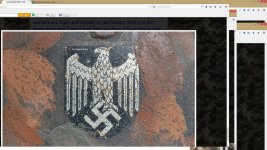 AUTUMN DECAL.jpg312.2 KB · Views: 19
AUTUMN DECAL.jpg312.2 KB · Views: 19 -
 AUTUMN DECAL DETAIL.jpg300.8 KB · Views: 16
AUTUMN DECAL DETAIL.jpg300.8 KB · Views: 16
Last edited:
M45
Well-known member
ebeeby; you are referring to the Dot Pattern Camo - Fall colors, I presume.
It looks like an original SD Heer M42 NS maker, but the added dot camo is questionable. There looks like evenly-distributed moderate wear all over this helmet, which is unnatural, IMO. I would expect to see heavy wear to the very crown of this helmet where it was set down repeatedly, causing a smoother patina on top and even worn to the factory paint below in places. What I see is not the way front-line helmets normally wear in combat. The split rivets show no appreciable wear as is seen on worn authentic examples.
It looks like an original SD Heer M42 NS maker, but the added dot camo is questionable. There looks like evenly-distributed moderate wear all over this helmet, which is unnatural, IMO. I would expect to see heavy wear to the very crown of this helmet where it was set down repeatedly, causing a smoother patina on top and even worn to the factory paint below in places. What I see is not the way front-line helmets normally wear in combat. The split rivets show no appreciable wear as is seen on worn authentic examples.
Last edited:
ebeeby
Senior Member
ebeeby; you are referring to the Dot Pattern Camo - Fall colors, I presume.
It looks like an original SD Heer M42 NS maker, but the added dot camo is questionable. There looks like evenly-distributed moderate wear all over this helmet, which is unnatural, IMO. I would expect to see heavy wear to the very crown of this helmet where it was set down repeatedly, causing a smoother patina on top and even worn to the factory paint below in places. What I see is not the way front-line helmets normally wear in combat. The split rivets show no appreciable wear as is seen on worn authentic examples.
AH-so. Thank you. It looked to my novice eye as a relic shell that had been painted. The "DOT CAMO" must be a very thick sort of splatter paint?
M45
Well-known member
M35 Army helmet w/chicken-wire camouflage
M35 Army helmet w/chicken-wire camouflage
http://www.germanhelmetsinc.com/gallery.htm
The paint looks like it was applied yesterday. No attempt at all to age it. No wear evident.
M35 Army helmet w/chicken-wire camouflage
http://www.germanhelmetsinc.com/gallery.htm
The paint looks like it was applied yesterday. No attempt at all to age it. No wear evident.
Attachments
Last edited:
M45
Well-known member
AH-so. Thank you. It looked to my novice eye as a relic shell that had been painted. The "DOT CAMO" must be a very thick sort of splatter paint?
Some places are a bit thicker. Remember the '1 second-rule' for camos? Supposedly, an original camo will be evident to you as original within 1 second of seeing it. For me, the helmet fails the 1-second rule.
M45
Well-known member
Q64 m40 medic helmet
EBAY: Winning bid:
US $4,002.00
WWII German DN358 Helmet and Leather Liner and Chin Strap, Painted, Size 064
Leather is dry, but still flexible.
Helmet weighs 3 lbs. 5 oz.
Interior inscription:
"Med Off Zolt
Ostbunker Medical Academey
Capture 9/44"
On Nov-08-14 at 09:30:08 PST, seller added the following information:
Helmet History...
This helmet is from the estate of one of my clients. My client's uncle (still living) was a medical officer stationed in Germany during the Normandy Invasion. He brought this helmet, and other relics, back to the States after the war. This helmet has been in storage (and well preserved) for decades. It is definitely authentic.
I have sold other items on eBay from this estate including: Armand Marseille Painted Eye Googly Doll; 1930s Wood Pastime Puzzles; Lady Constance and EAM sterling silver chargers; Vintage Gorham silver baby cup; vintage glass, linens, and collectibles.
Please contact me with any questions.
***Someone on the WRF forum bought this helmet. Some posts: http://www.warrelics.eu/forum/steel-helmets/german-medic-helmet-494210-6/
--Helmet arrived today. It's 100% authentic including period applied white paint and reddish / brown cross (with a beautiful patina). I have handled enough helmets (real and fake) to say that with confidence.
The liner system is unmolested--perfectly bent pins (no recent scratches) and all washers are present. A couple things not evident in the EBay photos: 1.) the liner is named in pencil to a "Dr. _ _ _-I can't make out the name (might be initials) 2.) think I can see a Heer shaped decal ghosting and 3.) the tip of the chinstrap has some faded white paint.
Does anyone know if Quist made KM m40 helmets? If so, any known examples with a lot number close to this one?
Anyways, more to follow...
--I really do hope that this is as authentic as you believe, but there are few points that worry me, firstly in the description of the veterans exploits, it is stated that he still has a few snapshots, his medals and uniform, no mention of a helmet, which in my opinion would be a talking point when explaining to reporters re his mementos, secondly this phrase that his relation is using "Repainted", I would assume that most younger women have no idea as to how a helmet should look, let alone paint ,camo schemes etc, for all she would know is that the helmet is supposed to look like that, so why use that phrase, unless she knows that possibly her relation painted it after the war as a form of tribute to medics of either side, you must admit this is a possibility, i,m not saying it was painted a few weeks ago, but there is a possibility it was done just post war, which would account for the age effect, also ,would medic helmets be painted with a permanent paint or white wash, as it appears that this helmet has a smooth finish as opposed to the heavier coating of the latter and was at one time a decalled combat helmet
It looks like the penciled writing convinced this person this is an authentic medical helmet. While the writing looks good, it looks to have been written by the allied soldier who captured it. The paint looks no better than any other postwar done med helmet I've seen. Lots and lots of $$$$. The battle is on for collector's hard-earned dollars !!
EBAY: Winning bid:
US $4,002.00
WWII German DN358 Helmet and Leather Liner and Chin Strap, Painted, Size 064
Leather is dry, but still flexible.
Helmet weighs 3 lbs. 5 oz.
Interior inscription:
"Med Off Zolt
Ostbunker Medical Academey
Capture 9/44"
On Nov-08-14 at 09:30:08 PST, seller added the following information:
Helmet History...
This helmet is from the estate of one of my clients. My client's uncle (still living) was a medical officer stationed in Germany during the Normandy Invasion. He brought this helmet, and other relics, back to the States after the war. This helmet has been in storage (and well preserved) for decades. It is definitely authentic.
I have sold other items on eBay from this estate including: Armand Marseille Painted Eye Googly Doll; 1930s Wood Pastime Puzzles; Lady Constance and EAM sterling silver chargers; Vintage Gorham silver baby cup; vintage glass, linens, and collectibles.
Please contact me with any questions.
***Someone on the WRF forum bought this helmet. Some posts: http://www.warrelics.eu/forum/steel-helmets/german-medic-helmet-494210-6/
--Helmet arrived today. It's 100% authentic including period applied white paint and reddish / brown cross (with a beautiful patina). I have handled enough helmets (real and fake) to say that with confidence.
The liner system is unmolested--perfectly bent pins (no recent scratches) and all washers are present. A couple things not evident in the EBay photos: 1.) the liner is named in pencil to a "Dr. _ _ _-I can't make out the name (might be initials) 2.) think I can see a Heer shaped decal ghosting and 3.) the tip of the chinstrap has some faded white paint.
Does anyone know if Quist made KM m40 helmets? If so, any known examples with a lot number close to this one?
Anyways, more to follow...
--I really do hope that this is as authentic as you believe, but there are few points that worry me, firstly in the description of the veterans exploits, it is stated that he still has a few snapshots, his medals and uniform, no mention of a helmet, which in my opinion would be a talking point when explaining to reporters re his mementos, secondly this phrase that his relation is using "Repainted", I would assume that most younger women have no idea as to how a helmet should look, let alone paint ,camo schemes etc, for all she would know is that the helmet is supposed to look like that, so why use that phrase, unless she knows that possibly her relation painted it after the war as a form of tribute to medics of either side, you must admit this is a possibility, i,m not saying it was painted a few weeks ago, but there is a possibility it was done just post war, which would account for the age effect, also ,would medic helmets be painted with a permanent paint or white wash, as it appears that this helmet has a smooth finish as opposed to the heavier coating of the latter and was at one time a decalled combat helmet
It looks like the penciled writing convinced this person this is an authentic medical helmet. While the writing looks good, it looks to have been written by the allied soldier who captured it. The paint looks no better than any other postwar done med helmet I've seen. Lots and lots of $$$$. The battle is on for collector's hard-earned dollars !!
Attachments
Last edited:
M45
Well-known member
3-color camo
3-COLOR CAMO
http://www.italianwarfront.com/?page_id=1715
Well distributed very minor wear overall, the same to the top of the crown; unnatural wear, IMO. The paint on the front pins is in pristine condition. Typically, the paint here takes a beating.
3-COLOR CAMO
http://www.italianwarfront.com/?page_id=1715
Well distributed very minor wear overall, the same to the top of the crown; unnatural wear, IMO. The paint on the front pins is in pristine condition. Typically, the paint here takes a beating.
Attachments
Last edited:


